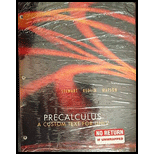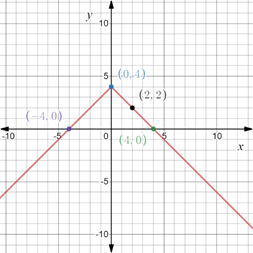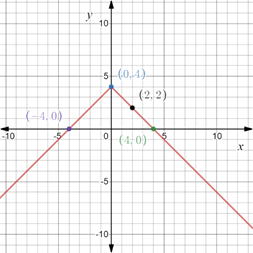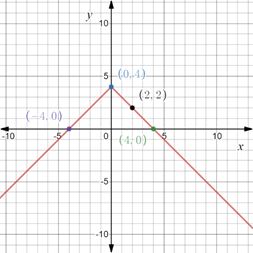
Concept explainers
To calculate: The x- and y- intercepts for the equation
Answer to Problem 75E
The x-intercepts are

Explanation of Solution
Given information:
The equation
Formula used:
The function is symmetric about the x-axis, when y is replaced by
The function is symmetric about the y-axis, when x is replaced by
The function is symmetric with respect to origin, when y is replaced by
The x-intercepts are the points on x-axis where the graph of the equation intersects the x-axis.
The y-intercepts are the points on y-axis where the graph of the equation intersects the y-axis.
Calculation:
It is provided that the equation is
Substitute the point
Substitute the point
Substitute the point
Substitute the point
Construct a table with the values obtained above,
In the coordinate plane plot the points obtained above and connect them through a line.
The graph of the equation is provided below

Recall that the x-intercepts are the points on x-axis where the graph of the equation intersects the x-axis.
Substitute
Therefore, x-intercepts are
Recall that the y-intercepts are the points on x-axis where the graph of the equation intersects the y-axis.
Substitute
Therefore, y-intercept is
Recall that the function is symmetric about the x-axis, when y is replaced by
Replace y by
The equation is changed. Therefore, the equation
Recall that the function is symmetric about the y-axis, when x is replaced by
Replace x by
The equation is unchanged. Therefore, the equation
Recall that the function is symmetric with respect to origin, when y is replaced by
Replace x by
The equation is changed. Therefore, the equation
Thus, the x-intercepts are

Chapter 1 Solutions
Precalculus - A Custom Text for UNLV
- A 20 foot ladder rests on level ground; its head (top) is against a vertical wall. The bottom of the ladder begins by being 12 feet from the wall but begins moving away at the rate of 0.1 feet per second. At what rate is the top of the ladder slipping down the wall? You may use a calculator.arrow_forwardExplain the focus and reasons for establishment of 12.4.1(root test) and 12.4.2(ratio test)arrow_forwarduse Integration by Parts to derive 12.6.1arrow_forward
- Explain the relationship between 12.3.6, (case A of 12.3.6) and 12.3.7arrow_forwardExplain the key points and reasons for the establishment of 12.3.2(integral Test)arrow_forwardUse 12.4.2 to determine whether the infinite series on the right side of equation 12.6.5, 12.6.6 and 12.6.7 converges for every real number x.arrow_forward
- use Corollary 12.6.2 and 12.6.3 to derive 12.6.4,12.6.5, 12.6.6 and 12.6.7arrow_forwardExplain the focus and reasons for establishment of 12.5.1(lim(n->infinite) and sigma of k=0 to n)arrow_forwardExplain the focus and reasons for establishment of 12.5.3 about alternating series. and explain the reason why (sigma k=1 to infinite)(-1)k+1/k = 1/1 - 1/2 + 1/3 - 1/4 + .... converges.arrow_forward
 Calculus: Early TranscendentalsCalculusISBN:9781285741550Author:James StewartPublisher:Cengage Learning
Calculus: Early TranscendentalsCalculusISBN:9781285741550Author:James StewartPublisher:Cengage Learning Thomas' Calculus (14th Edition)CalculusISBN:9780134438986Author:Joel R. Hass, Christopher E. Heil, Maurice D. WeirPublisher:PEARSON
Thomas' Calculus (14th Edition)CalculusISBN:9780134438986Author:Joel R. Hass, Christopher E. Heil, Maurice D. WeirPublisher:PEARSON Calculus: Early Transcendentals (3rd Edition)CalculusISBN:9780134763644Author:William L. Briggs, Lyle Cochran, Bernard Gillett, Eric SchulzPublisher:PEARSON
Calculus: Early Transcendentals (3rd Edition)CalculusISBN:9780134763644Author:William L. Briggs, Lyle Cochran, Bernard Gillett, Eric SchulzPublisher:PEARSON Calculus: Early TranscendentalsCalculusISBN:9781319050740Author:Jon Rogawski, Colin Adams, Robert FranzosaPublisher:W. H. Freeman
Calculus: Early TranscendentalsCalculusISBN:9781319050740Author:Jon Rogawski, Colin Adams, Robert FranzosaPublisher:W. H. Freeman
 Calculus: Early Transcendental FunctionsCalculusISBN:9781337552516Author:Ron Larson, Bruce H. EdwardsPublisher:Cengage Learning
Calculus: Early Transcendental FunctionsCalculusISBN:9781337552516Author:Ron Larson, Bruce H. EdwardsPublisher:Cengage Learning





